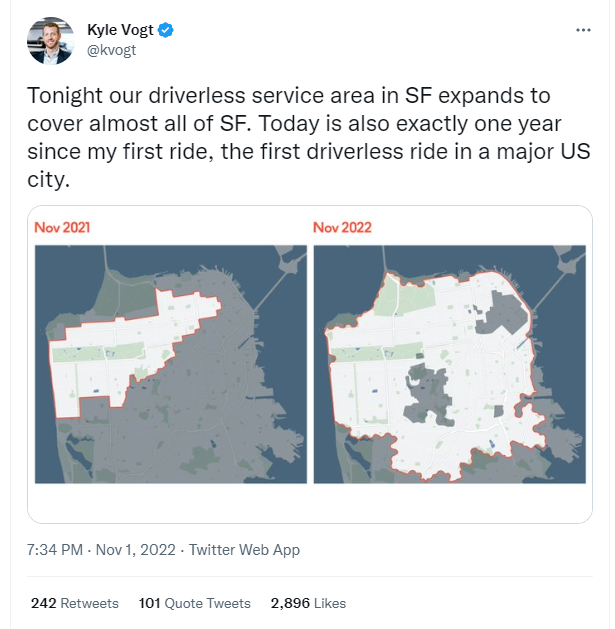Cruise Expands Robotaxi Service Across San FranciscoCruise Expands Robotaxi Service Across San Francisco
The expansion represents tangible progress for Cruise, on top of its announcement that it aims to start operations in Phoenix and Austin

Cruise has significantly expanded the area its robotaxis cover in San Francisco.
The General Motors-owned company has been operating its self-driving vehicles in parts of the California city since last year, and in June became the first company to be granted a permit to run a commercial driverless service.
With that milestone achieved, it is now extending its coverage right across San Francisco.
The news was announced in a series of tweets from CEO Kyle Vogt. He wrote: “Tonight [1 November] our driverless service area in SF expands to cover almost all of SF. Today is also exactly one year since my first ride, the first driverless ride in a major U.S. city.
“The new service area goes live for Cruisers today and likely to the public in a few weeks. Cruise’s updated service area now includes the Mission, Marina, Presidio, etc.”
Vogt posted before and after images of maps that demonstrated the scale of the expansion. On the former, only a relatively compact area of the city was highlighted, whereas on the latter most of San Francisco is now Cruise territory, with only two major areas out of bounds.

He continued: “The two larger holes are Twin Peaks (mostly open space and closed roads) and FiDi [Financial District] (SF’s busiest neighborhood – we’ll get there soon).
“AV [autonomous vehicle] progress continues to accelerate. Wild that only a year ago, I took the first-ever driverless Cruise ride and tonight I can take a driverless ride almost anywhere in SF.
“Over 400,000 driverless miles later, and we’re just getting started. The rest of this year is going to be fun.”
The “Cruisers” Vogt refers to are employees, and although there is mention of the service being made available to “the public,” anyone interested in traveling will still have to sign up for the company’s waitlist. And the robotaxis are likely only to be offered at limited times – the current permit specifies the hours of operation as between the hours of 10 p.m. and 6 a.m.
Nevertheless, the expansion represents tangible progress for Cruise, on top of its announcement that it aims to start operations in Phoenix and Austin, after a difficult period.
The San Francisco rollout hasn’t been without its hitches, with a technical gremlin causing an unexpected gathering of robotaxis in July, blocking off a street, and a software recall prompted by a crash between a Cruise AV and Toyota Prius on June 3. The readiness of the tech has also been questioned – even by city transit bosses who highlighted concerns to the National Highway Traffic Safety Administration.
The company’s finances have been under scrutiny, too – not least since it was revealed GM was losing $5 million a day on Cruise.
Concerns about how long it will take AVs to achieve profitability recently caused Ford and Volkswagen to pull the plug on Cruise rival Argo AI.
About the Author
You May Also Like







